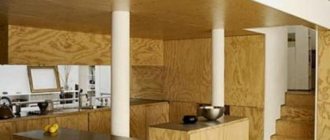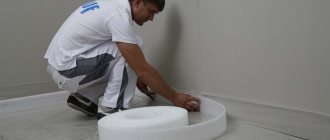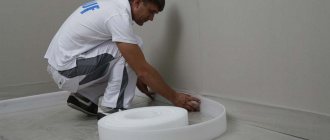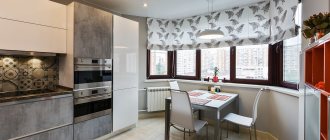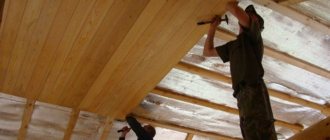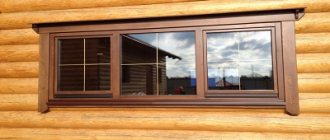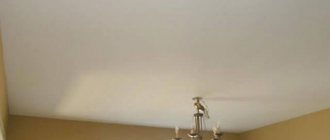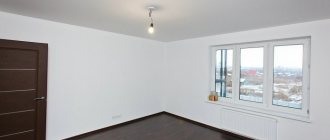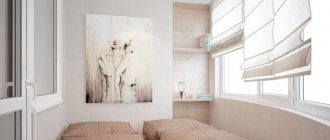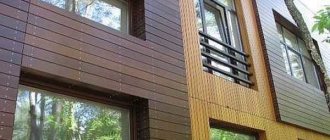SHARE ON SOCIAL NETWORKS
FacebookTwitterOkGoogle+PinterestVk
Wood is considered one of the best finishing materials for a country house. It is environmentally friendly and safe for humans. It is for this reason that in the photos of modern interiors you can see a wooden ceiling in the house. Finishing work is easy to do with your own hands. This article will help you understand the question of which materials are best suited for these purposes, as well as choose the most optimal way to decorate the ceiling.
Wood cladding is the best option, as it is environmentally friendly and will help maintain a favorable microclimate in the house.
What should be the ceiling materials in wooden houses?
Ceiling systems in wooden buildings have structural specificity. You need to choose in advance how to make the ceiling in the house, what materials to use. Most often we are talking about light beam floors and plank flooring. To fill the distance between the beams, special insulation is used.
When choosing what can be used to sheathe the ceilings in a wooden house, you should take into account the following wishes for its characteristics:
- Light weight, good insulation and sound insulation characteristics.
- Safety. The ceiling finish must be durable, reliable and fire resistant. It should not contain harmful toxins.
- Durability. The long service life of the ceiling system will make it possible to forget about repairs for a long time.
- Aesthetics. It is recommended to select a finish that matches the design of the walls. In this case, you can achieve unity of style, which will help create comfort and attractiveness.
Most often, natural materials are used in wooden houses to promote good air circulation inside the ceiling finish. It is very important that the design fits well into the overall style of the room’s decoration.
Preparatory activities
Before installing the selected ceiling system, the surface of the ceiling is impregnated with special antiseptic liquids. If there is consistently high humidity in the room (bathroom, kitchen, bathhouse), additional treatment with a waterproofing agent is carried out. It is important to provide fire protection to the surface. For these purposes, special impregnations containing fire retardants are used.
Wooden ceiling cladding is processed in the same way. This allows you to significantly extend the life of the elements and protect them from possible deformation. Before installing the sheathing, thermal insulation of the ceiling is carried out. For these purposes, it is allowed to use any insulation. They can be installed under a decorative surface or in the attic. During the preparation process, wiring and other communications are laid.
Floors of a private house and their structure
In order for all work on finishing the ceiling space to be carried out in accordance with all rules and construction requirements, it is necessary to understand what the section of the ceiling is.
The standard floor structure consists of:
- interior decoration, which often does not have any useful function, but has a decorative function,
- vapor barrier film that will protect a residential building from moisture from the outside,
- layer of heat-insulating material, the purpose of this layer is simple - to insulate the house, starting with insulating the ceiling,
- waterproofing – helps the insulation not to get wet on the outside,
- flooring or flooring of the upper floor (not a mandatory item if you do not plan to use the room that is located directly above the finishing area).
Features of finishing materials
When choosing a suitable option for covering a wooden ceiling, not only quality and cost are taken into account, but also compliance with the overall design style of the room. In some cases, additional sheathing is not used at all (the insulating layer is laid on the attic side). Thanks to the open beams on the ceiling surface, you can create an original country house style (the so-called “country” style).
Sometimes the parameters of the timber or logs used in the construction of a home are such that it is possible to do without additional thermal insulation. Wood is characterized by the presence of such specific qualities as the ability to absorb excess moisture. Its release occurs when the air becomes too dry. Wood is a good insulator and provides good noise protection.
Most often, lumber, supplemented with plywood, lining, veneer panels or solid wood, is used as ceiling finishing in wooden houses. In the case of external insulation of the walls of the house, their surface is hidden by the finishing. In cases where it is not designed to look like wood, the ceiling can be decorated with plastic, plasterboard or suspended ceilings.
Making your own mixture
It is not always possible to find the right color of putty, and in this case, it becomes more difficult to find something to fill the cracks in the ceiling between the boards. However, there is a universal remedy that allows you to match the tone of the main surface almost perfectly. This is a homemade mixture.
It is prepared from sawdust obtained by sanding the same boards that were used to assemble the covering. PVA glue or any colorless wood varnish is added to the sawdust. The density of the mixture is selected experimentally. After the composition is ready, it is applied and subsequently processed in the same way as putty.
Lining
This material for finishing the ceiling in a log house is lightweight and environmentally friendly. This finish goes well with the walls of a wooden house. To reduce the cost of purchasing material, you can choose lining made from inexpensive wood. Installation of lamellas is facilitated by longitudinal tongues and grooves on the end faces.
Classification of lining:
- Extra. The most suitable material for sewing up the ceiling in the house. Expensive wood is used as a manufacturing material.
- A and B. There may be minor imperfections in the finish. This does not in any way reduce the strength characteristics of the material.
- C. Budget option, for the manufacture of which inexpensive wood species are used. The finishing surface contains flaws and a large number of knots.
Wedges
A slightly complicated method that gives an effect comparable in appearance, but much more practical, is driving a strip into the gap, the sides of which are planed along the length so that it looks like a very long wedge. To seal defects, the dimensions of the slats are selected slightly smaller than the existing gap.
The prepared parts are coated with glue and driven into the desired location along the entire length of the defect. After all the wedges have been driven in, a layer of putty mixture or a self-made sawdust solution is spread over the installed parts. Further actions occur after the applied compositions have dried and copy the actions of the previous two methods.
Veneered panels
A material very similar to lining. The difference concerns the use of inexpensive wood for the manufacture of panels, which is covered with a thin veneer of expensive species on top. This allows you to imitate the luxury finish of a wooden ceiling in a private house. The dimensions of veneered panels differ from the lining.
Stretch ceiling
The material used for the ceiling in the house is PVC film or fabric without seams. Stretch ceilings are convenient because even if a wooden house shrinks, they retain their configuration. However, if the stretch ceiling in a wooden house with beams is seriously damaged, the canvas must be replaced.
Slatted wooden ceilings
Before covering the ceiling in a private house with a slatted system, preliminary arrangement of the sheathing will be required. When attaching slats and lamellas, it is possible to create a continuous surface without gaps. For joining, decorative panels are equipped with closed grooves. Joining with gaps is also possible when open type grooves are used.
Sometimes these gaps are decorated with special decorative inserts. Rack suspended structures make it possible to lay utility lines (electrical wires, air ducts, various cables) between the decorative surface and the base. Thermal insulation material can be used to fill the free niche.
How to install lining
Most often, lining is used to decorate a wooden ceiling in a private house with your own hands. This makes it possible to create a closed cladding.
The ceiling lining has the following dimensions:
- Length: 2-4 m.
- Width: 70-150 mm.
- Thickness: 10-25 mm.
By measuring the ceiling in a room, you can quickly determine the required amount of material. If cheap lining is used, it is recommended to purchase spare elements in case serious defects are discovered. The frame for covering the ceiling with wood is usually constructed from pine beams with a cross-section of 40x40 mm. The timber is calculated based on the length and width of the room, the size of the supporting central beams and the number of special fastening clamps.
Before decorating the ceiling in a wooden house, it is necessary to arrange the lathing. Work on its construction begins with marking the perimeter of the room. It is necessary to mark a line along the walls at a certain height. To control the accuracy of construction activities, a water or laser level is used. Next, a guide beam is installed on the finished sheathing using nails or self-tapping screws. The task becomes much easier if you drill through holes. Another option is to use a furniture corner.
A guide in the form of a nylon thread or fishing line is stretched along the lower part of the guide beam between the walls. This makes it possible to obtain a flat plane of the supporting structure. The support beam is installed at regular intervals, focusing on the guide thread. Decorative panels are installed on the finished frame.
The first and all subsequent elements are fixed to the sheathing using small nails or self-tapping screws. To achieve a good fit of the skin, individual elements are tapped with a rubber hammer. Dense placement of lining in the area of walls or load-bearing structures is prohibited. It is necessary to leave a certain distance in case of expansion of wooden elements with increasing air humidity. Decorative plinth is used to mask cracks.
Budget methods of ceiling finishing
When choosing the appropriate option for covering the ceiling in a wooden house, the cost of the material is of great importance. In cases where the budget does not allow the purchase of expensive natural materials, they can be replaced with cheaper imitations. For example, inexpensive plastic panels are available in a wide variety of colors and textures. The wood-like plastic surface goes well with wooden walls.
Using white panels without seams, you can create a surface that is in no way inferior to expensive stretched fabrics. Another option for a budget material for finishing the ceiling in a wooden house is MDF panels laminated to resemble a wooden texture. Pine lining, when properly designed, resembles finishing made from valuable species. To do this, it is impregnated with stain and varnished. You can do the same with plywood sheathing.
Recommendations for carrying out repair work
If you decide to cover the ceiling with clapboard, the first thing you need to do is choose the right type of wood and type of profile . There are only three standardized grades: A, B and C. If financial capabilities do not allow you to buy the first grade (A), you can choose the second (B). They differ mainly in the number and size of knots.
There are lumber manufacturers who offer “Extra” . You should know that this variety is not included in the state standard. It (the grade) was invented by manufacturers in order to sell high-quality lumber that does not meet the requirements of the first grade.
It is recommended to choose wood with a low degree of resin content . For an economy option, the best choice is spruce. This lining is distinguished by its light color, beautiful texture and durability. Spruce boards have much fewer knots than other coniferous trees.
Additional decorations for the ceiling
The ceiling decoration can be made so unusual that it will transform the entire interior. This is achieved through various combinations of materials and elements.
For this, the following materials are used for the ceiling in a wooden house:
- Decorative panels
. This refers to wooden elements made to order for a specific room. The cost of such finishing is quite high. Solid wood, decorated with beautiful carvings, can be used as raw materials. - False beams and beams
. To decorate a wooden ceiling in a private house, it is enough to correctly use the elements of the ceiling structure. For example, if you make the beams dark and the ceiling fabric light, you get a very effective finish. This way you can achieve a visual increase in space. In cases where the beams are covered with sheathing, imitation timber is used. - Alfrey finish
. This is the name given to the decoration. To accomplish this, several methods are used: images can be rolled with a roller or printed using a stencil. Sometimes panels are pulled out and painted surfaces are trimmed. This is a rather rare way to decorate the ceiling in a wooden house inside, which goes well with the classic vintage design. In modern styles it is practically not used.
How to sheathe a ceiling in a wooden house: requirements for sheathing and materials necessary for work
Before you go to the store to buy finishing material for the ceiling, you need to make sure that the cladding will meet all the requirements.
The most important condition for creating a high-quality ceiling is safety. The result should be reliable and strong. In addition, the coating must meet all fire safety rules. It is not permitted to use materials that emit hazardous or harmful substances into the air. Moreover, this requirement applies to finishes that are under normal operating conditions, as well as those that are subject to heating.
The material for finishing the ceilings in the house must be in harmony with other elements of the room, creating a unified design
Durability is no less important when building a country house. The longer the ceiling maintains its operational and technical characteristics, the less often there will be a need for repair or restoration. Particular attention should be paid to the decorative component. Materials that will be used to finish wooden ceilings in an apartment or house must be in harmony with other elements of the room, creating a unified design.
Since country houses can be used not only for seasonal, but also for permanent residence, the issue of heat preservation is extremely important. According to the laws of physics, thermal energy rises along with heated air. Therefore, you definitely need to learn how to properly insulate the ceiling in a wooden house in order to reduce heating costs.
How to hem a ceiling on wooden beams: choice of material
Natural wood is considered the most optimal finishing material for country housing. The construction market offers dozens of cladding options for ceilings in a wooden house with beams. The most budget-friendly of them is lining; the most expensive finishing coating is considered to be natural wood. Therefore, the choice of material depends not only on personal preferences, but also on the financial capabilities of the home owner.
The most prestigious type of finishing for beams is natural wood, which is produced in the form of convenient, practical panels
If desired, you can combine different types of finishes to get a unique and one-of-a-kind result. It is allowed to use plywood as sheathing. Also, wooden ceilings in the interior can be decorated using lumber trim.
The following types of wood are used for these purposes:
- alder;
- maple;
- beech;
- oak;
- birch;
- cherries;
- ash.
Coniferous wood is also suitable for finishing. All these materials differ in color, texture and pattern.
If you combine different types of finishes, you can get a unique and unique ceiling
Popular coniferous tree species:
- larch;
- spruce;
- cedar;
- pine;
- fir.
Important! When selecting lumber for finishing ceilings, you must check the humidity level. The maximum figure for natural wood raw materials is 16%. If you use wet material in your work, over time it will dry out and become severely deformed.
Characteristics of lining ceilings: photos and specificity of the material
Lining is a board that goes through a special processing procedure. It is equipped with grooves and a longitudinal tongue, which greatly simplifies the installation process. This material is characterized by high strength, durability, environmental friendliness and excellent sound insulation properties. The lining is of natural origin, so the finishing on the ceiling “breathes”. In addition, the affordable price makes this type of material one of the most attractive options.
Lining is a board that is processed in a special way and has a groove and tongue for easier installation
To finish the ceiling with clapboard, materials of various classes are used:
- Extra is a high quality material that does not have defects in the form of unevenness and knots. For the production of this lining, expensive wood is used.
- Class A and B - panels and slats have minor defects that do not affect the strength characteristics of the material.
- Class C - inexpensive wood is used to produce the material; a large number of knots and irregularities are allowed. The lining of this class belongs to the most budget category.
Unlike cheaper material options, Extra class eurolining is equipped with a high-quality locking structure. Designs using this finish can be very diverse. If the lining is installed in the space between the beams, you can divide the ceiling into zones. To do this, it is enough to lay the material in different directions and select cladding of different shades for the job.
In small rooms it is better to lay the lining in one direction. It is not recommended to use this technique in spacious rooms, since the interior will turn out to be too monotonous and boring.
Helpful advice! To make the solid surface of the lining look interesting, the coating can be decorated with painting or carving. This design looks very elegant and is often used in old houses to create a colorful interior.
The distinctive features of lining are strength and durability, it is a good sound insulator
Features of finishing ceilings in a wooden house using plywood
Despite the fact that plywood is used much less often than other materials as a ceiling finish, it can be used to create an attractive design without additional costs. There are many varieties and types of plywood on the market. First of all, sheets are classified according to the number of layers that have been glued together.
In addition, the material is divided into categories according to the following criteria:
- Grade – five grades of construction plywood can be used as cladding.
- The degree of moisture resistance - this indicator will make itself felt at a time when the house is not heated, so the level of moisture resistance should be given special attention when choosing a material.
- Type of wood - the top layer of the plywood sheet is usually made of alder, birch or maple; coniferous species are used to produce the middle layers.
- Processing method - if the renovation is carried out in a country house, you can limit yourself to using untreated plywood. If the room is used year-round, it is better to give preference to sheets sanded on only one side. Plywood with double-sided sanding is also available on sale, but in this case there is no need for such material.
- Decorative qualities - plywood sheets can be decorated with plastic, asbestos paper, imitation wood pattern or pattern.
Plywood is an inexpensive and practical material that is advisable to use for ceiling cladding
Before finishing the ceiling with plywood, you will have to build a lathing structure from wooden slats or metal profiles. The sheet material is fixed to the frame with nails or self-tapping screws. After this, all joints are sealed with putty or masked using decorative slats. Plywood sheets are ideal for decorating ceilings in the attic, although this material can also be used for finishing other rooms.
Helpful advice! If you cover plywood sheets with a laminate, the degree of moisture resistance of the coating will increase significantly.
Specificity of finishing ceiling panels: veneered elements and solid wood
The most prestigious finishing option is natural wood. It is manufactured in the form of practical and convenient panels.
This type of material has many useful properties and characteristics:
- long service life;
- high safety margin;
- aesthetic appearance;
- high quality, which directly depends on the selected wood species;
- simple and easy installation system thanks to the built-in locking system.
Veneer can imitate the appearance of any valuable type of wood, depending on each person's preferences
For the production of wooden ceiling panels, hardwoods are usually used, which have the necessary characteristics.
If you can’t afford the purchase of solid wood trim, you can limit yourself to purchasing panels coated with veneer. These elements are made in the form of planks. On the outside they are covered with a thin layer of natural veneer, which quite realistically imitates any type of wood. The range of such products is varied and allows you to choose panels of any design or color. The cost of veneer coating is slightly higher than the price of lining, but this finish has many more decorative options.
Painting a wooden ceiling and alfrey finishing
Alfrey finishing is called ceiling painting. This type of design is currently used extremely rarely, but experts advise not to neglect this method of decorating ceilings.
By using alfresco painting, you can radically transform the appearance of your home at a low cost. Moreover, it is not at all necessary to paint the entire area of the ceiling with patterns. Drawings can be placed locally or along the perimeter, creating a specific design.
Painting a wooden ceiling is an important procedure that prolongs its service life
Alfrey artistic finishing is performed in various ways:
- trimming a pre-painted surface;
- rolling a pattern using a roller;
- pulling out panels;
- printing patterns using stencils.
Note! Alfrey finishing is suitable for rooms with a classic design, stylized as antique. It is not recommended to combine artistic painting with modern design trends.
Average prices for alfresco painting
| Name of works | Price, rub./m² |
| Simple patterns | From 2500 |
| Patterns of medium complexity | From 4900 |
| Complex alfresco painting | From 8500 |
If alfrey finishing is not affordable, you can choose to paint the ceiling in a single color.
Cost of painting a wooden ceiling per square meter
| Name of works | Price, rub./m² |
| Water-based paint (single-layer painting) | 120 |
| Water-based paint (two-layer painting) | 230 |
| Water-based paint (three-layer painting) | 300 |
Several types of water-based dyes are used for wood processing:
- silicone;
- acrylic;
To cover the ceiling, it is best to use products that preserve the natural texture of wood
- silicate;
- mineral.
The exact cost of painting depends on the complexity of the work and the type of composition that will be used.

